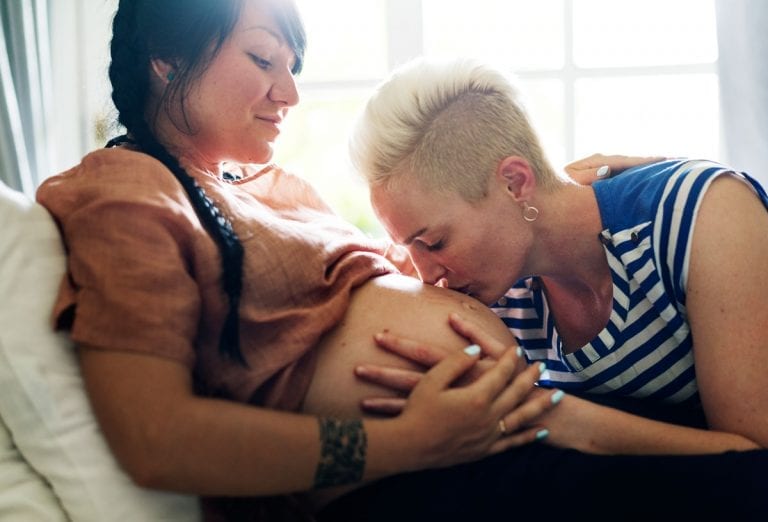We live in a world where love, gentle parenting, LGBTQ activism, social justice reform and science have brought us to a place where people who choose to parent are able to do so with integrity and a full spectrum of choices to support optimum health and attachment within their created families.
Co-Nursing in Lesbian Families
Most lesbian women who get pregnant and give birth can breastfeed their babies. One advantage families with two mommies have is that both parents may breastfeed their babies. If the non-gestational parent chooses to induce lactation, both moms can share in breastfeeding, or “co-nursing.” Inducing lactation for the mother who doesn’t give birth does requires time and preparation, but it can give her the bonding and maternal health benefits breastfeeding offers.
Also, with co-nursing, there’s so much more milk to go around, making everyone’s breastfeeding goals a little easier. Many gestational mamas welcome the opportunity to share the responsibility of nighttime breastfeeding with their wife or partner! To learn more about induced lactation, see our article on breastfeeding for adoptive and surrogate parents.
Breastmilk Feeding in Gay Couples
When two cisgender gay men choose to have a baby, either through adoption or surrogacy, they will be bottle feeding. But that doesn’t necessarily mean feeding infant formula. There are many options to bottle feed human breastmilk from surrogates or a donor, to name two.
Surrogate Milk: Couples who create their family with a surrogate often include lactation, pumping and the provision of breastmilk in their contracts. This lets baby receive milk that’sfull of beneficial hormones and antibodies and made to meet baby’s individual nutritional and immunological needs.
Banked Donor Milk: The Human Milk Bank Association of North America is 18 non-profit milk banks in the US and Canada that accept milk from donors who have been screened for substances and risk factors and tested for blood-borne diseases. Donated milk is tested and pasteurized before distribution.
Milk banks primarily provide donor milk to hospitals, but they also provide milk for babies at home who have certain medical or feeding issues. Banked donor milk is a scarce resource so it’s not usually available to healthy adopted babies, but there are some exceptions. Due to its scarcity and cost incurred with screening and processing, it’s not cheap. Learn more at hmbana.org.
Informal Donor Milk: Milk sharing is as old as humanity. Long ago, wet nurses were life-saving and sustaining for children whose mothers who didn’t make enough milk or who died in childbirth. Because human milk offers such significant health benefits, some families still seek donors through informal milk sharing networks like Human Milk 4 Human Babies or Eats on Feets. Know it’s against the law to sell or purchase human breastmilk this way in the U.S.
Transgender Parents
Transgender mothers and fathers can make milk and feed their babies, just like cisgender women can. Both men and women have breast tissue—just add a functional pituitary gland. This process can be incredibly empowering and affirming for transgender parents; it can create feelings of gender dysphoria for others. Only you can decide what is right for you or your family.
Transgender Fathers: Transgender men who choose to gestate and give birth may also choose to chest-feed/nurse their babies as the process is usually biological and physiologically normal. Transgender fathers who haven’t been pregnant may also choose to induce lactation.
In doing so, transgender fathers may experience breast tissue growth and swelling, both during pregnancy and the postpartum period, as their mammary glands begin lactating. Avoid binding during this process, especially after your milk “comes in” during the postpartum period, as this can lead to plugged milk ducts, mastitis, and a lot of pain and potentially, infection.
Even if you have previously had surgery, you will likely still experience mammary growth, estrogen, progesterone, and prolactin will be busy doing their jobs. This may create feelings of gender dysphoria, particularly among men who never felt comfortable having breasts. Those feelings are OK! This is where lots of support and self-awareness are key.
How much milk you make will depend in part on biology and technique, as well as whether you’ve had top surgery. If you’ve had this surgery, your milk production may be limited by the extent of glandular tissue that was removed. Still, regarding human milk feeding, every drop counts! Consider working with an LGBTQ-informed International Board Certified Lactation Consultant (IBCLC) at ilca.org to maximize your success.
Transgender Mothers: There have been remarkable breakthroughs on lactation for transgender women. Recently, Transgender Health published the journey of a transgender woman who had completed her transition six years prior and who successfully induced lactation. In this case, her breast development had reached Tanner Stage V, meaning her breasts were well-developed. She had not undergone any gender-affirming surgeries. While she did have to supplement her baby’s feedings with formula beginning at six weeks, she continued to breastfeed. This transgender woman’s success with lactation was comparable to what we would have expected in a cisgender woman who induced lactation.
It’s important to work closely with both an LGBTQ-informed endocrinologist and an IBCLC regarding which lactation induction method may work best for you, and success varies from woman to woman, depending largely on how completely developed a woman’s breasts are before she begins the process of inducing lactation. In addition, gender affirming breast surgery is not required, and may make lactation more difficult.
Further reading: Exploring Nipple Shields for Breastfeeding Problems
Top 5 Breastfeeding Positions
What to eat and drink during breastfeeding






Comments are closed.